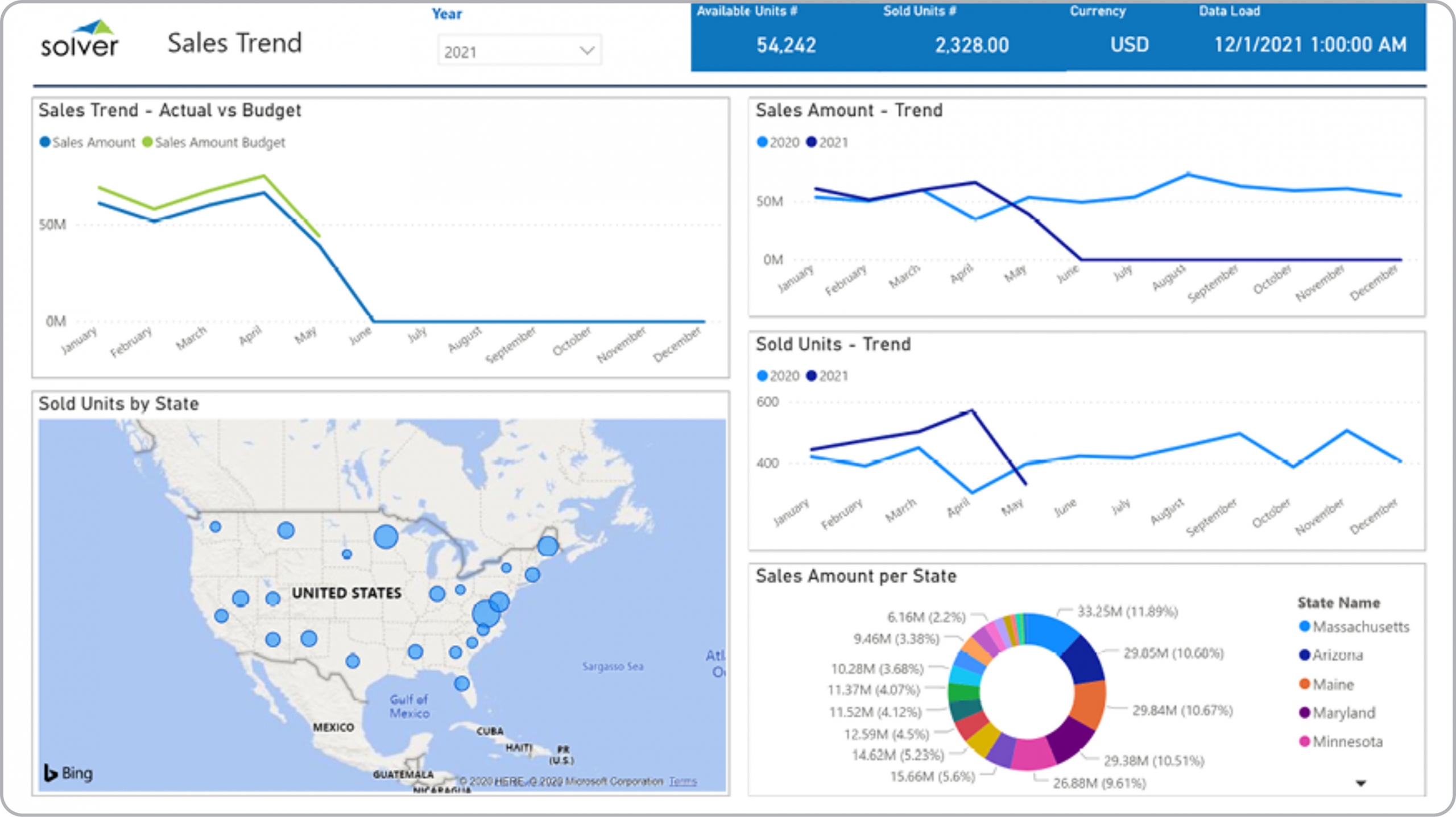Sales Trend and KPI Dashboard for Real Estate Companies
What is a
Sales Trend and KPI Dashboard
? Real Estate Sales Dashboards are considered performance analysis tools and are used by CFOs and Analysts to monitor sales-related KPIs across all their offices and agents. Some of the main functionality in this type of dashboard is that it shows metrics from six different perspectives: 1) Monthly actual versus budget sales trend, 2) Sold units by state (with drill-down), 3) Total monthly sales amount trend for current year versus prior year, 4) Total monthly sold units for current year versus prior year, 4) Sales amount per region, and 5) KPIs for Total available units and Total sold units. You find an example of this type of dashboard below.
Purpose of Real Estate
Sales Trend and KPI Dashboards Real Estate organizations use Sales Trend and KPI Dashboards to provide corporate managers an essential sales monitoring tool. When used as part of good business practices in Financial Planning & Analysis (FP&A) and sales departments, an organization can improve and speed up its strategic decisions and grow revenues, and it can reduce the chances of managers reacting late to trends or anomalies.
Example of a
Real Estate Sales Trend and KPI Dashboard Here is an example of a Sales Trend and KPI Dashboard with geographical and monthly variance analysis. [caption id="" align="alignnone" width="2560"]
 Example of a Sales Trend and KPI Dashboard for Real Estate Companies[/caption] You can find hundreds of additional examples
here
Who Uses This Type of
Dashboard
? The typical users of this type of dashboard are: Executives, CFOs, analysts, regional managers.
Other Reports Often Used in Conjunction with
Real Estate Sales Trend and KPI Dashboards Progressive Financial Planning & Analysis (FP&A) departments sometimes use several different Sales Trend and KPI Dashboards, along with financial dashboards, consolidated and local office profit & loss reports, sales reports, sales forecast, annual budgets and other management and control tools.
Where Does the Data for Analysis Originate From? The Actual (historical transactions) data typically comes from enterprise resource planning (ERP) systems like: Microsoft Dynamics 365 (D365) Finance, Microsoft Dynamics 365 Business Central (D365 BC), Microsoft Dynamics AX, Microsoft Dynamics NAV, Microsoft Dynamics GP, Microsoft Dynamics SL, Sage Intacct, Sage 100, Sage 300, Sage 500, Sage X3, SAP Business One, SAP ByDesign, Acumatica, Netsuite and others. In analyses where budgets or forecasts are used, the planning data most often originates from in-house Excel spreadsheet models or from professional corporate performance management (CPM/EPM) solutions.
What Tools are Typically used for Reporting, Planning and Dashboards? Examples of business software used with the data and ERPs mentioned above are:
Example of a Sales Trend and KPI Dashboard for Real Estate Companies[/caption] You can find hundreds of additional examples
here
Who Uses This Type of
Dashboard
? The typical users of this type of dashboard are: Executives, CFOs, analysts, regional managers.
Other Reports Often Used in Conjunction with
Real Estate Sales Trend and KPI Dashboards Progressive Financial Planning & Analysis (FP&A) departments sometimes use several different Sales Trend and KPI Dashboards, along with financial dashboards, consolidated and local office profit & loss reports, sales reports, sales forecast, annual budgets and other management and control tools.
Where Does the Data for Analysis Originate From? The Actual (historical transactions) data typically comes from enterprise resource planning (ERP) systems like: Microsoft Dynamics 365 (D365) Finance, Microsoft Dynamics 365 Business Central (D365 BC), Microsoft Dynamics AX, Microsoft Dynamics NAV, Microsoft Dynamics GP, Microsoft Dynamics SL, Sage Intacct, Sage 100, Sage 300, Sage 500, Sage X3, SAP Business One, SAP ByDesign, Acumatica, Netsuite and others. In analyses where budgets or forecasts are used, the planning data most often originates from in-house Excel spreadsheet models or from professional corporate performance management (CPM/EPM) solutions.
What Tools are Typically used for Reporting, Planning and Dashboards? Examples of business software used with the data and ERPs mentioned above are:
- Native ERP report writers and query tools
- Spreadsheets (for example Microsoft Excel)
- Corporate Performance Management (CPM) tools (for example Solver)
- Dashboards (for example Microsoft Power BI and Tableau)
Corporate Performance Management (CPM) Cloud Solutions and More Examples
March 20, 2021
TAGS:
Reporting,
Solver,
report writer,
Microsoft,
template,
practice,
Acumatica,
agency,
visualization,
Netsuite,
Finance,
planning,
GP,
dashboard,
realtor agent,
Business Central,
state,
excel,
ax,
realtor,
forecast,
Budget,
Dynamics 365,
budgeting,
Cloud,
Software,
Tableau,
SAP,
example,
best,
Sage,
BC,
D365,
agent,
NAV,
Intacct,
Real Estate,
CPM,
report,
SL,
Management,
dynamics,
sales,
Power BI,
property,
real estate sales dashboard,
sales per region,
sold units

